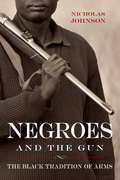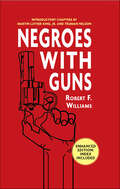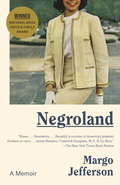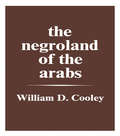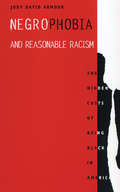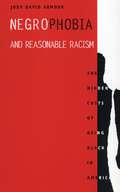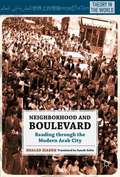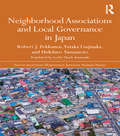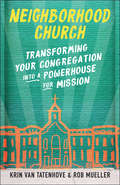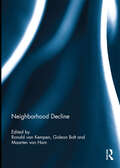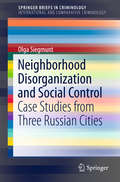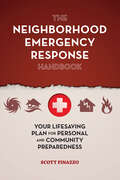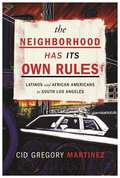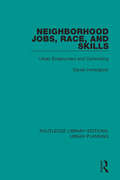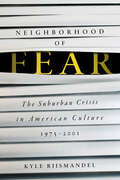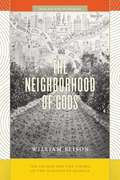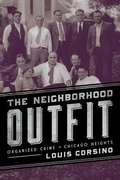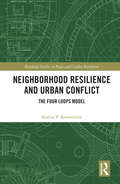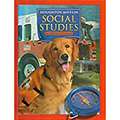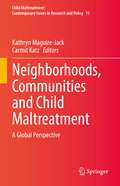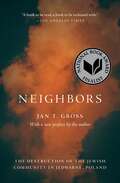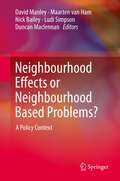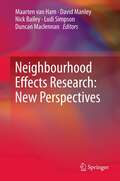- Table View
- List View
Negroes and the Gun
by Nicholas JohnsonChronicling the underappreciated black tradition of bearing arms for self-defense, this book presents an array of examples reaching back to the pre--Civil War era that demonstrate a willingness of African American men and women to use firearms when necessary to defend their families and communities. From Frederick Douglass's advice to keep "a good revolver" handy as defense against slave catchers to the armed self-protection of Monroe, North Carolina, blacks against the KKK chronicled in Robert Williams's Negroes with Guns, it is clear that owning firearms was commonplace in the black community. Nicholas Johnson points out that this story has been submerged because it is hard to reconcile with the dominant narrative of nonviolence during the civil rights era. His book, however, resolves that tension by showing how the black tradition of arms maintained and demanded a critical distinction between private self-defense and political violence. Johnson also addresses the unavoidable issue of young black men with guns and the toll that gun violence takes on many in the inner city. He shows how complicated this issue is by highlighting the surprising diversity of views on gun ownership in the black community. In fact, recent Supreme Court affirmations of the right to bear arms resulted from cases led by black plaintiffs. Surprising and informative, this well-researched book strips away many stock assumptions of conventional wisdom on the issue of guns and the black freedom struggle.From the Trade Paperback edition.
Negroes with Guns
by Robert F. WilliamsThe Quintessential Exploration of the Role of Violence in Protecting Civil Rights This enhanced edition includes an index. "I do not advocate violence for its own sake, or for the sake of reprisals against whites. Nor am I against the passive resistance advocated by the Reverend Martin Luther King," Robert F. Williams wrote in his prologue to Negroes with Guns. "But where there is a breakdown of the law, the individual citizen has a right to protect his person, his family, his home and his property." In 1961 Mr Williams led his Monroe, North Carolina community to arm themselves in the face of racist violence. This book spells out his belief that the ability to defend oneself is a legal right which could prevent racist incidents from occurring, and that self-defense compelled law enforcement agencies into action. "The lawful authorities of Monroe and North Carolina acted to enforce order . . . as a direct result of us being armed." As a result of his movement, Williams was vilified and framed, and subsequently fled the country, but his account of his struggle for the rights White America takes for granted remains a searing testimony to the racism which continues to plague the nation to this day. This book vividly captures effect of the debate in the Black community between non-violent and violent defense of civil rights as it played out in the 1960s. Williams graphically details his ongoing struggle with the Ku Klux Klan and the black community's attempt at armed defense. Framing this struggle in a wider context are essays on non-violence by the Reverend Martin Luther King, Jr., and abolitionist scholar Truman Nelson, who discusses the divergent views of King and Williams.
Negroland: A Memoir
by Margo JeffersonWinner of the National Book Critics Circle Award<br> Winner of the Heartland Prize<br> A New York Times Notable Book<br> One of the Best Books of the Year: The Washington Post, Los Angeles Times, Time, Vanity Fair, Marie Claire, Time Out New York, Minneapolis Star Tribune, Kansas City Star, Men’s Journal, Oprah.com <p><p>At once incendiary and icy, mischievous and provocative, celebratory and elegiac--here is a deeply felt meditation on race, sex, and American culture through the prism of the author's rarefied upbringing and education among a black elite concerned with distancing itself from whites and the black generality while tirelessly measuring itself against both. <p> Pulitzer Prize–winning cultural critic Margo Jefferson was born in 1947 into upper-crust black Chicago. Her father was head of pediatrics at Provident Hospital, while her mother was a socialite. In these pages, Jefferson takes us into this insular and discerning society: “I call it Negroland,” she writes, “because I still find ‘Negro’ a word of wonders, glorious and terrible.” <p> Negroland’s pedigree dates back generations, having originated with antebellum free blacks who made their fortunes among the plantations of the South. It evolved into a world of exclusive sororities, fraternities, networks, and clubs—a world in which skin color and hair texture were relentlessly evaluated alongside scholarly and professional achievements, where the Talented Tenth positioned themselves as a third race between whites and “the masses of Negros,” and where the motto was “Achievement. Invulnerability. Comportment.” Negroland is a landmark work on privilege, discrimination, and the fallacy of post-racial America.
The Negroland of the Arabs Examined and Explained (1841): Or an Enquiry into the Early History and Geography of Central Africa
by William Desborough CooleyInitially published in 1841 and written in language of the time, this is W.D Cooley's investigation which has formed a basis for future studies. His spirit for inquiry led him into the diverse fields of geography, mathematics, and linguistics and here is his inquiry into the Early History and Geography of Central Africa.
Negrophobia and Reasonable Racism: The Hidden Costs of Being Black in America (Critical America #32)
by Jody David ArmourTackling the ugly secret of unconscious racism in American society, this book provides specific solutions to counter this entrenched phenomenon.
Negrophobia and Reasonable Racism: The Hidden Costs of Being Black in America (Critical America #32)
by Jody David ArmourTackling the ugly secret of unconscious racism in American society, this book provides specific solutions to counter this entrenched phenomenon.
Neighborhood and Boulevard
by Khaled ZiadehCombines the styles of memoir, history, anthropology, and theory to develop an innovative reflection on the materiality of culture. Through its style and content, the text challenges the Orientalist bifurcation between tradition and modernity in the Arab world, revealing instead tradition's own dynamism and its coexistence alongside modernity.
Neighborhood Associations and Local Governance in Japan (Nissan Institute/Routledge Japanese Studies)
by Robert J. Pekkanen Yutaka Tsujinaka Hidehiro YamamotoAlthough local neighborhood associations are found in many countries, Japan’s are distinguished by their ubiquity, scope of activities, and very high participation rates, making them important for the study of society and politics. Most Japanese belong to one local neighborhood association or another, making them Japan’s most numerous civil society organization, and one that powerfully shapes governance outcomes in the country. And, they also often blur the state-society boundary, making them theoretically intriguing. Neighborhood Associations and Local Governance in Japan draws on a unique and novel body of empirical data derived from the first national survey of neighborhood associations carried out in 2007 and provides a multifaceted empirical portrait of Japan’s neighborhood associations. It examines how local associational structures affect the quality of local governance, and thus the quality of life for Japan’s citizens and residents, and illuminates the way in which these ambiguous associations can help us refine civil society theory and show how they contribute to governance. As well as outlining the key features of neighbourhood associations, the book goes on to examine in detail the way in which neighbourhood associations contribute to governance, in terms of social capital, networks with other community organizations, social service provision, cooperation with local governments and political participation. This book will be welcomed by students and scholars of Japanese politics, Japanese society, anthropology, urban studies as well as those interested in social capital and civil society.
Neighborhood Church: Transforming Your Congregation Into A Powerhouse For Mission
by Rob Mueller Krin TatenhoveHow can we embody the values of love, grace, and justice? As faith communities, how can our collective embodiment of these values shine even brighter? The answers to these questions must always unfold right here, right now, exactly where God has planted us. Neighborhood Churchacts as a resource to inspire churches to become a vibrant and engaging community partner with the families and neighborhoods living around them. The need for transformation is acute. Congregational decline continues across all mainline denominations. The abandonment of the church by the millennial generation is ubiquitous; no denomination is escaping it. This is, in part, a consequence of disconnection from our communities. Van Tatenhove and Mueller believe that, parish by parish, we can reverse this trend. They dare to have an audacious hope for local congregations not only as signs of God’s kingdom but as life-giving institutions that anchor their neighborhoods. Drawing on their combined sixty years of parish experience, wisdom from Asset-Based Community Development, and compelling case stories, Van Tatenhove and Mueller do more than just call us to incarnational ministry. They give practical, essential tools that lead to communal conversion, develop the DNA of listening, spur fruitful partnerships, promote integrated space, and sustain long-term visions. They believe these tools will spark true revival and unleash the power of incarnational ministry.
Neighborhood Decline
by Ronald van Kempen, Gideon Bolt and Maarten van HamThe global financial and economic crisis that hit the world since 2008 has affected the lives of many people all over the world and resulted in declining incomes, rising unemployment, foreclosures, forced residential moves, and cut-backs in government expenditure. The extent to which the crisis has affected urban neighborhoods and has led to rising intra-urban inequalities, has not yet received much attention. The implemented budget cuts and austerity programs of national and local governments are likely to have hit some neighborhoods more than others. The authors of this this book, which come from a variety of countries and disciplines, show that the economic crisis has affected poor neighborhoods more severely than more affluent ones. The tendency of the state to retreat from these neighborhoods has negative consequences for their residents and may even nullify the investments that have been made in many poor neighborhoods in the recent past. This book was originally published as a special issue of Urban Geography.
Neighborhood Disorganization and Social Control
by Olga SiegmuntThis Brief presents a framework for understanding the role of school and neighborhood contexts in the development of self-control. Through the application of Gottfredson and Hirschi's general theory of crime and Shaw and McKay's social disorganization theory, the authors of this Brief examine the importance of family socialization and school and neighborhood for self-control of youth in three Russian cities, replicating results from an earlier study in Germany. The cases presented in the Brief found that family socialization is important for self-control, but it interacts with school and neighbourhood contexts. According to the study, school social control as a structural characteristic can lead to less delinquency, even if students did not develop self-control. Self-control mediates parental supervision and attachment to parents on one hand, and juvenile delinquency on the other hand. However it was not found to mediate neighbourhood context characteristics. The results of the study provide a research framework that can be applied to other international, comparative contexts. It will be of interest to researchers in Criminology and Criminal Justice, particularly Developmental and Life-Course Criminology, as well as related fields such as Public Policy and Social Work.
The Neighborhood Emergency Response Handbook: Your Life-Saving Plan for Personal and Community Preparedness
by Scott FinazzoA COMPLETE, STEP-BY-STEP GUIDE TO PREPARING YOURSELF AND YOUR COMMUNITY TO AID FIRST RESPONDERS DURING A DISASTER SITUATION Nothing brings out the best in neighbors more than facing a catastrophe together. But don’t wait till the disaster is upon you. This book shows how you can work together today to protect the lives and homes of all the families in your neighborhood tomorrow. With guidance on how you can take a leadership role, this helpful handbook details everything your community needs to be fully prepared for any natural disaster. * Creating event-specific disaster kits for yourself and your family * Learning about basic fire safety and fire fighting * Establishing triage centers in the event that first responders can’t reach you * Stabilizing disaster victims through need-to-know first aid * Creating your own neighborhood emergency response team to keep your neighborhood safe and save lives should the worst occur
The Neighborhood Has Its Own Rules: Latinos and African Americans in South Los Angeles
by Cid MartinezSouth Los Angeles is often seen as ground zero for inter-racial conflict and violence in the United States. Since the 1940s, South LA has been predominantly a low-income African American neighborhood, and yet since the early 1990s Latino immigrants—mostly from Mexico and many undocumented—have moved in record numbers to the area. Given that more than a quarter million people live in South LA and that poverty rates exceed 30 percent, inter-racial conflict and violence surprises no one. The real question is: why hasn't there been more? Through vivid stories and interviews, The Neighborhood Has Its Own Rules provides an answer to this question. Based on in-depth ethnographic field work collected when the author, Cid Martinez, lived and worked in schools in South Central, this study reveals the day-to-day ways in which vibrant social institutions in South LA— its churches, its local politicians, and even its gangs—have reduced conflict and kept violence to a level that is manageable for its residents. Martinez argues that inter-racial conflict has not been managed through any coalition between different groups, but rather that these institutions have allowed established African Americans and newcomer Latinos to co-exist through avoidance—an under-appreciated strategy for managing conflict that plays a crucial role in America's low-income communities. Ultimately, this book proposes a different understanding of how neighborhood institutions are able to mitigate conflict and violence through several community dimensions of informal social controls.
Neighborhood Jobs, Race, and Skills: Urban Employment and Commuting (Routledge Library Editions: Urban Planning #13)
by Daniel ImmergluckOriginally published in 1998, Neighbourhood Jobs, Race, and Skills argues that race is a powerful and persistent barrier to employment. Analysing existing literature, this book outlines how racial discrimination in hiring against African Americans appears to remain a contributor to high unemployment rates in black neighbourhoods. The book also discusses how issues such as poor schools and physical and social isolation compound employment problems, as well as changes in policy on skill requirements and the location of jobs. The book argues that combined, this is a major contributor to concentrated urban employment and poverty.
Neighborhood of Fear: The Suburban Crisis in American Culture, 1975–2001
by Kyle RiismandelHow—haunted by the idea that their suburban homes were under siege—the second generation of suburban residents expanded spatial control and cultural authority through a strategy of productive victimization.The explosive growth of American suburbs following World War II promised not only a new place to live but a new way of life, one away from the crime and crowds of the city. Yet, by the 1970s, the expected security of suburban life gave way to a sense of endangerment. Perceived, and sometimes material, threats from burglars, kidnappers, mallrats, toxic waste, and even the occult challenged assumptions about safe streets, pristine parks, and the sanctity of the home itself. In Neighborhood of Fear, Kyle Riismandel examines how suburbanites responded to this crisis by attempting to take control of the landscape and reaffirm their cultural authority.An increasing sense of criminal and environmental threats, Riismandel explains, coincided with the rise of cable television, VCRs, Dungeons & Dragons, and video games, rendering the suburban household susceptible to moral corruption and physical danger. Terrified in almost equal measure by heavy metal music, the Love Canal disaster, and the supposed kidnapping epidemic implied by the abduction of Adam Walsh, residents installed alarm systems, patrolled neighborhoods, built gated communities, cried "Not in my backyard!," and set strict boundaries on behavior within their homes. Riismandel explains how this movement toward self-protection reaffirmed the primacy of suburban family values and expanded their parochial power while further marginalizing cities and communities of color, a process that facilitated and was facilitated by the politics of the Reagan revolution and New Right.A novel look at how Americans imagined, traversed, and regulated suburban space in the last quarter of the twentieth century, Neighborhood of Fear shows how the preferences of the suburban middle class became central to the cultural values of the nation and fueled the continued growth of suburban political power.
The Neighborhood of Gods: The Sacred and the Visible at the Margins of Mumbai (South Asia Across the Disciplines)
by William ElisonThere are many holy cities in India, but Mumbai is not usually considered one of them. More popular images of the city capture the world’s collective imagination—as a Bollywood fantasia or a slumland dystopia. Yet for many, if not most, people who live in the city, the neighborhood streets are indeed shared with local gods and guardian spirits. In The Neighborhood of Gods, William Elison examines the link between territory and divinity in India’s most self-consciously modern city. In this densely settled environment, space is scarce, and anxiety about housing is pervasive. Consecrating space—first with impromptu displays and then, eventually, with full-blown temples and official recognition—is one way of staking a claim. But how can a marginalized community make its gods visible, and therefore powerful, in the eyes of others? The Neighborhood of Gods explores this question, bringing an ethnographic lens to a range of visual and spatial practices: from the shrine construction that encroaches on downtown streets, to the “tribal art” practices of an indigenous group facing displacement, to the work of image production at two Bollywood film studios. A pioneering ethnography, this book offers a creative intervention in debates on postcolonial citizenship, urban geography, and visuality in the religions of India.
The Neighborhood Outfit: Organized Crime in Chicago Heights
by Louis CorsinoFrom the slot machine trust of the early 1900s to the prolific Prohibition era bootleggers allied with Al Capone, and for decades beyond, organized crime in Chicago Heights, Illinois, represented a vital component of the Chicago Outfit. Louis Corsino taps interviews, archives, government documents, and his own family's history to tell the story of the Chicago Heights "boys" and their place in the city's Italian American community in the twentieth century. Debunking the popular idea of organized crime as a uniquely Italian enterprise, Corsino delves into the social and cultural forces that contributed to illicit activities. As he shows, discrimination blocked opportunities for Italians' social mobility and the close-knit Italian communities that arose in response to such limits produced a rich supply of social capital Italians used to pursue alternative routes to success that ranged from Italian grocery stores to union organizing to, on occasion, crime.
Neighborhood Resilience and Urban Conflict: The Four Loops Model (Routledge Studies in Peace and Conflict Resolution)
by Karina V. KorostelinaThis book explores the resilience in urban neighborhoods affected by chronic conflict and violence, developing a new model for improving resilience policies. The neighborhood resilience approach is an inclusive form of building positive resilience, which recognizes that local communities possess valuable skills and experience of dealing with crises, and prioritizes the agency of local communities in the production of knowledge and developing practices. The book identifies and describes the repertoire of neighborhood resilience practices organized in four clusters: (1) addressing the structure of conflict; (2) increasing the effectiveness of external resources; (3) enhancing the community capacities; and (4) reflecting the dynamics of identity and power in neighborhoods. One of the key findings of the book is the nonlinear connections between structure and dynamics of conflict and neighborhood resilience practices represented in the Four Loops Model. The concentration on community-based practices addresses macro-level critiques of neo-liberalism in critical resilience studies and encourages rethinking the ways community-based indicators might operate in combination with existing macro indicators of resilience. The bottom-up indicators provide more specific details and essential localized experiences for improving resilience policies at the national level. This book will be of much interest to students of conflict resolution, resilience, urban studies, and US politics.
Neighborhoods, Communities and Child Maltreatment: A Global Perspective (Child Maltreatment #15)
by Kathryn Maguire-Jack Carmit KatzThis volume explores methods for studying child maltreatment in the context of neighborhoods and communities, given their importance in the lives of families. It discusses the ways in which neighborhoods have changed over time and how this that has impacted parenting in the modern context. It also highlights the ways in which policies have contributed to persistent poverty and inequality, which indirectly impacts child maltreatment. An important focus of this volume is to examine the multitude of ways in which the neighborhood context affects families, including structural factors like poverty, segregation, residential instability, and process factors like social cohesion. The volume takes a critical look at the ways in which culture and context affect maltreatment through a community-based approach, and uses this approach to understand child maltreatment in rural areas. The editors and contributors explore innovative prevention approaches and reflect on the future of this field in terms of what remains unknown, how the information should be used to guide policy in the future, and how practitioners can best support parents while being mindful of the importance of context. Addressing an important topic, this volume is of relevance and interest to a wide readership of scholars and students in the social and behavioral sciences, as well as to practitioners and policy makers working with neighborhoods and communities.
Neighbors: The Destruction of the Jewish Community in Jedwabne, Poland
by Jan T. GrossA landmark book that changed the story of Poland’s role in the HolocaustOn July 10, 1941, in Nazi-occupied Poland, half of the town of Jedwabne brutally murdered the other half: 1,600 men, women, and children—all but seven of the town’s Jews. In this shocking and compelling classic of Holocaust history, Jan Gross reveals how Jedwabne’s Jews were murdered not by faceless Nazis but by people who knew them well—their non-Jewish Polish neighbors. A previously untold story of the complicity of non-Germans in the extermination of the Jews, Neighbors shows how people victimized by the Nazis could at the same time victimize their Jewish fellow citizens. In a new preface, Gross reflects on the book’s explosive international impact and the backlash it continues to provoke from right-wing Polish nationalists who still deny their ancestors’ role in the destruction of the Jews.
Neighbors In Need: Zimbabweans Seeking Refuge in South Africa
by Human Rights WatchThis 119-page report examines South Africa's decision to treat Zimbabweans merely as voluntary economic migrants and its failure to respond effectively to stop the human rights abuses and economic deprivation in Zimbabwe that cause their flight and to address their needs in South Africa. Human Rights Watch spoke to almost 100 Zimbabweans in South Africa about their plight.
Neighbourhood Effects or Neighbourhood Based Problems?: A Policy Context
by Nick Bailey Duncan Maclennan Ludi Simpson Maarten Van Ham David ManleyThis edited volume critically examines the link between area based policies, neighbourhood based problems, and neighbourhood effects: the idea that living in disadvantaged neighbourhoods has a negative effect on residents' life chances over and above the effect of their individual characteristics. Over the last few decades, Western governments have persistently pursued area based policies to fight such effects, despite a lack of evidence that they exist, or that these policies make a difference. The first part of this book presents case studies of perceived neighbourhood based problems in the domains of crime; health; educational outcomes; and employment. The second part of the book presents an international overview of the policies that different governments have implemented in response to these neighbourhood based problems, and discusses the theoretical and conceptual processes behind place based policy making. Case studies are drawn from a diverse range of countries including the United Kingdom, The Netherlands, Australia, Canada, and the USA.
Neighbourhood Effects Research: New Perspectives
by Nick Bailey Duncan Maclennan Ludi Simpson Maarten Van Ham David ManleyOver the last 25 years a vast body of literature has been published on neighbourhood effects: the idea that living in more deprived neighbourhoods has a negative effect on residents' life chances over and above the effect of their individual characteristics. The volume of work not only reflects academic and policy interest in this topic, but also the fact that we are still no closer to answering the question of how important neighbourhood effects actually are. There is little doubt that these effects exist, but we do not know enough about the causal mechanisms which produce them, their relative importance in shaping individual's life chances, the circumstances or conditions under which they are most important, or the most effective policy responses. Collectively, the chapters in this book offer new perspectives on these questions, and refocus the academic debate on neighbourhood effects. The book enriches the neighbourhood effects literature with insights from a wide range of disciplines and countries.
